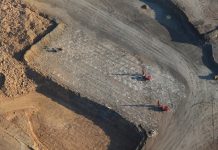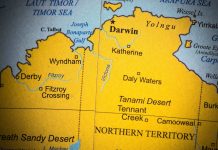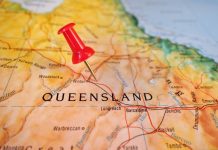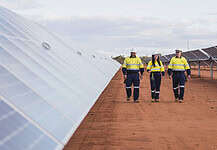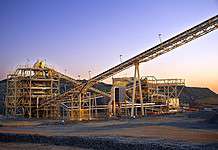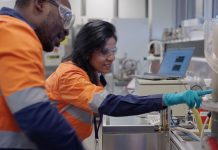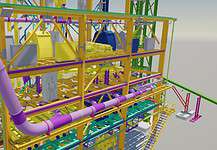Mining has long been a backbone of North West Queensland’s economy but now it will prove crucial to pulling Australia out of the coronavirus recession.
Queensland’s mining industry is the state’s most valuable sector, accounts for 40% of all capital expenditure and directly employs nearly 65,000 people with nearly a quarter of them working at mines in North Queensland.
The North West Minerals Province (NWMP), centered around Cloncurry and Mt Isa, is one of the world’s greatest mining regions and holds about 75% of Queensland’s base metal mineral endowment including copper, lead, zinc and silver as well as major phosphate deposits.
The big players employ thousands with even the Mt Isa mayor, Danielle Slade, getting her first job straight out of school at Glencore’s Mt Isa Mines (MIM) where she worked for 25 years.
MIM – which includes George Fisher mine, Glencore’s Lady Loretta and Ernest Henry Mines – MMG’s Dugald River zinc mine, Capricorn Copper, South 32’s Cannington Mine, New Century Resources’ Century mine and Round Oak Minerals’ operations are the major mines currently operating in the NWMP.
“Mining is the backbone of the Mt Isa economy and is the reason for the city’s existence,” Ms Slade said.
“The mining industry accounts for more than 30% of the workforce.
“The next biggest industry is education at 7% followed by the hospital at 4.5%, so it goes to show just how vital mining is to our community.”
Ms Slade said there were several projects in the pipeline as the NWMP ushers in a new era of mining being driven by the quest for “new economy” minerals.
“These include some exciting advances made in exploring and testing for cobalt and rare-earth metals, which are needed for things like wind turbines, generators and batteries,” Ms Slade said.
“These are new-economy metals that will help strengthen and diversify the local mining industry and enable it to continue for many more decades to come.”
Queensland Mines Minister Anthony Lynham said the government had unveiled a $10m booster pack of grants to supercharge exploration, including bringing forward funds for the NWMP.
“Demand for the next generation of minerals is being driven by new technologies such as electric vehicles and renewable energy products, computers, smartphones and products for the medical, defence and scientific research sectors – and Queensland, especially the North West, is the place to get them,” Mr Lynham said.
Mt Isa to Townsville Economic Development Zone (MITEZ) CEO Glen Graham said there are several key enabler projects that will cater for the next phase of mining in the region, including the $1.5b CopperString 2.0 project, a transmission line that will connect the NWMP to the national electricity grid.

A CopperString report states there is $680b of known resources remaining in the Province, including $500b of “new economy” minerals such as copper, cobalt, gold, graphite, zinc, vanadium, gold and rare earth elements like rhenium.
Mr Graham said this had paved the way for new projects now underway or in the planning stages, such as Walford Creek Cobalt, Eva Copper and the Saint Elmo Vanadium Project.
He said Grand Central Industries’ multi-user intermodal freight terminal would also help unlock the full economic potential of the mining region.
Copper Mountain Mining Corporation (CMMC) completed an updated feasibility study in May for the Eva Copper project, which estimates total production of 1.5b pounds of copper over a 15-year mine life.
CMMC CEO Gil Clausen told the AMR the company is considering partnerships for the project and “would most definitely welcome discussions with Australian companies and entities”.
Mr Clausen said the company would be looking to hire locally, employing up to 460 people during construction and 300 when in operation.
Mr Clausen and Dugald River acting general manager Tim Akroyd both threw their support behind CopperString 2.0, which will drive down electricity prices in the region by 40% on average.
The high price of electricity and transporting products in regional Queensland are both impacting the competitiveness of mining operations across NWMP.
Mr Akroyd said the Dugald River mine, one of the world’s top 10 zinc operations owned by MMG Limited, was on track to produce about 2mt of ore a year for the next few years—more than the 1.7m originally forecast when the mine achieved commercial production in May 2018.
“It’s one of new projects that has come online which has demonstrated the continued value of the region,” Mr Akroyd said.
The mine had increased its expenditure on contracts with local and state-based businesses to just over $100m, representing 44% of their expenditure, in 2019, up from $96m, or 39%, in 2018.
Mr Akroyd said the mine has 250 employees and about 300 contractors but had rolled out a new incentives package and is working with Cloncurry Shire Council to entice more workers to the region.
Cloncurry Mayor Greg Campbell said there were hundreds of jobs going in the family-focused shire, which had earned Queensland’s ‘Friendliest Town’ award in 2013 and 2018.
“The opportunities to fast-track your career in this area are boundless,” Mr Campbell said.
“We have great schools, second-to-none health services and some of the best camping areas in the country.
“You can catch a 1m-long Barramundi five minutes from town, go water sking, stand-up-paddle-boarding, Mtain biking, horse riding and pretty much anything you consider to be a necessity in life.”
Mr Campbell said mining in the Cloncurry region, including the pursuit of “new technology minerals” would “play a big part in pulling the country out of recession”.
Apart from propping up the economy, he said the mining companies step up to the plate when the community faces hardship, with local mines playing a “critical” role in the council’s response to last year’s flood disaster, as an example.
A portion of Glencore’s Ernest Henry mine was used as a hay dump for the army to deliver hay to isolated cattle.
Miners rose to the challenge again when COVID-19 hit, employing a plethora of measures which has helped keep mine sites and the community free of the virus.
‘’They helped strengthen the temperature testing at the major airports at Townsville and Brisbane and we had the ability to do contact contracting through council very early on before the government app or anything was rolled out,’’ Mr Campbell said.
Glencore donated $725,000 towards finding a vaccine, as well as $45,000 to GeneXpert to enable local testing in Mt Isa and reduced wait times for results.
It’s testament to the huge social footprint Glencore has had in the area since Ernest Henry Mine became an integral part of the Cloncurry community 20 years ago.
EMH General Manager Aaron Harrison said even when the mine was in its infancy, it contributed more than $100m towards off-site infrastructure, including upgrades to Cloncurry air service and construction of a new terminal.
Mr Harrison said installation of power lines helped improve the reliability and capacity of Cloncurry’s electricity supply, while an extension of the mine’s pipeline transporting water from Lake Julius to Cloncurry helped secure the town’s future.
EMH had contributed more than $6m to the community in the past 10 years and supported countless projects at schools, medical centres and parks.
The decision in 2009 to transition from an open pit mine to an underground operation was another vote of confidence in the town, requiring a $589m investment to extend operations by 14 years until 2026, thus giving job security to more than 500 staff.
Just as new projects are coming online to seek out ‘’new economy’’ minerals, established mines like EMH will just as much a part of the new era of mining for the technological age.
‘’Our product gets used in a broad spectrum of ways, from the cables that feed electricity into our homes to the tiny connections in our computers and mobile phones, copper is an essential element in everyday life,’’ Mr Harrison said.
“Add to that copper’s extensive use in green technologies such as solar cells and electric cars, and it’s clear that copper has a vital role to play in the future of a sustainable world.’’

Glencore Queensland Metals CEO Matt O’Neill said MIM is one of Australia’s most iconic mining operations with a lease spanning 32,000ha and 52km from north to south.
‘’The site hosts the world’s largest zinc resources base, as well as one of the biggest networks of underground mine development in the world,’’ Mr O’Neill said.
It includes two underground copper mines (X41 and Enterprise), an underground zinc mine (George Fisher), a copper concentrator and smelter, a zinc-lead concentrator, lead smelter and zinc filter plant.
‘’Together these represent one of Australia’s largest industrial complexes,’’ Mr O’Neill said.
The Black Rock Cave project further develops the existing copper resource at MIM.
“In August 2020, the first production ore from the Black Rock Cave came online following the development of the mining levels, with the underground ore body expected to yield around 1.8mt of copper ore from 2020 to 2024,” Mr O’Neill said.
The company is in the final stages of reviewing the business case for the future of the copper smelter at Mt Isa and the Townsville Copper Refinery.
“These assets are facing significant competition from international smelters and refineries and high fixed costs like energy in Australia which negatively impacts their ongoing commercial viability,” Mr O’Neill said.
He said the Lady Loretta Mine, located 110km north-west of Mt Isa, had its first full year of production in 2019 and will produce about 1.6mt of high-grade zinc-lead-silver ore each year, which is transported to Mt Isa and blended with ore from the George Fisher Mine before processing.
He said Glencore was proud of the contribution Queensland Metals, which includes all mining, concentrating, smelting, refining and port operations, had made to the community.
‘’In 2019 that included providing work for 4720 people, working with 2790 suppliers and spending $1.6b on goods and services, with a substantial portion supporting regional businesses,’’ he said.
Operations at New Century Resources’ Century Mine continues to progress, with the mine re-established as a top 10 zinc producer globally, employing 350 personnel across its Lawn Hill mine site and Karumba Port facilities.
The mine has a forecast zinc production of 142kt for 2020 and is also continuing to recover and reprocess tailings.

